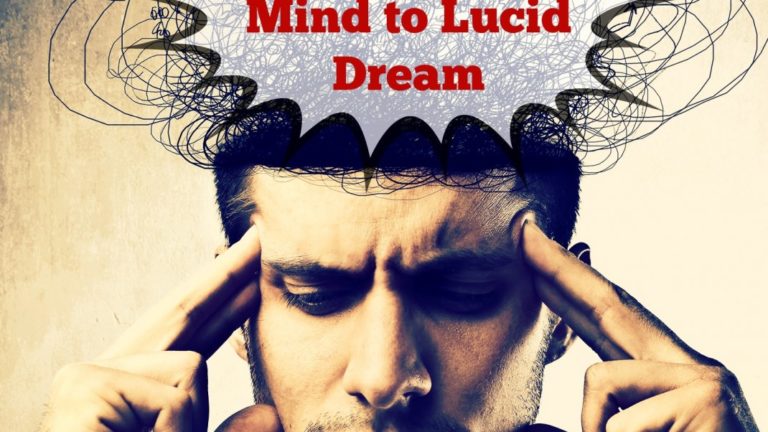Learn to Lucid Dream With These Techniques

Simply put, lucid dreaming is awareness of the fact that you are dreaming, but the spectrum which this covers is very broad. It can range from very faint recognition of the fact to something as momentous as a broadening of awareness beyond what has ever been experienced even in waking life. Usually, lucid dreams happen while a person is in the middle of a regular dream and suddenly realizes that she is dreaming. However, once she has this figured out, the ability to control one’s dreams comes into play, which is the sought-after part of lucid dreaming.
So how can you start lucid dreaming? You can start training your mind during your waking hours, so you can have more playtime during your dreaming ones. Try any combination of these methods:
“Am I Dreaming?”
During the day, repeatedly ask “Am I dreaming?” and perform some reality checks whenever you remember. This may sound silly (obviously, you aren’t dreaming during your waking hours), but it’s a form of mind training. With enough repetition and practice, you will automatically remember this action during your dreams and do it, thus gaining control.
Keep a Dream Journal
Don’t skip this one! This is perhaps the most important step towards lucid dreaming. Keep it close by your bed at night, and write in it immediately after waking. Don’t wander off, or you’re more likely to forget key details. If writing is too slow for you, though, try recording on your cell phone or typing.
Why keep a dream journal? It helps you recognize your common dream elements, such as people from your past, specific places, and so on. It will also help you to recognize things that are unique to your dreams. You will be able to recognize your own “dream signs.” These will be recurring things or events that you may notice in your dreams. It also tells your brain that you are serious about remembering your dreams.
Track Your Sleep Schedule
Learn the best time to have a lucid dream. By being aware of your personal sleep schedule, you can arrange your sleep pattern to help induce lucid dreams. Studies strongly suggest that a nap a few hours after waking in the morning is the most common time to have a lucid dream.
Lucid dreams are strongly associated with REM (rapid eye movement) sleep, which is much more common just before you wake up for the last time. Essentially, this means they most commonly occur right before waking up. Dreams usually run in 60-minute cycles during sleep. If you are working on dream recall, it may be helpful to try waking yourself up during one of these cycles (interrupted dreams are often the ones we remember).
The MILD Technique
A man by the name of Stephen Laberge’s came up with the mnemonic induction of lucid dreaming, dubbed MILD. You can try it by setting your alarm clock to wake you up 4 ½, 6, or 7 ½ hours after falling asleep. When you are awakened by your alarm clock, try to remember the dream as much as possible. After you think you have remembered as much as you can, return to your place of rest, imagining that you are in your previous dream, and becoming aware that you are dreaming. Make a dream mantra for yourself, somewhere along the lines of, “I will be aware that I’m dreaming,” or the like. Practice this until you think that it has sunk into your subconscious. Then return to your sleep.
If you don’t fall asleep right away and have random thoughts pop up when you are trying to fall asleep, repeat the imagining, self-suggestion part, and try again. Don’t worry if you think it’s taking a long time. The longer it takes, the more likely it will become part of your subconscious, and the more likely you will have a lucid dream.
The WBTB Technique
According to lucid dreaming proponents, the Wake Back To Bed practice is the most successful mind-training technique. Try it by setting your alarm clock to 5 hours after you fall asleep. After you wake up, stay up for an hour with your mind focused on lucidity and lucidity only. Then, go back to sleep using the MILD technique.
WILD Technique
This is the wake initiated lucid dream technique. At its core, it means is that when you fall asleep, you carry your awareness from when you were awake directly into REM sleep. Afterwards, you start out as a lucid dream.
The basics steps begin with meditating into a calm but focused state. You can try counting breaths, visualizations, being in a quiet soundproof area, whatever gets you Zen’ed. The next step is to get your body back to the brink of sleep. You can try lying in your bed and focusing your awareness onto the back of your head where it touches the pillow. Wait until your inner voice shuts off; then you can imagine sinking into your pillow until your body is just about asleep. Now, shift your awareness out of your body while trying to hold onto your awareness as tightly as possible. This will mean your body falls asleep and you will pass lucidly into the dream world.
Diamond Method of Meditation
Another technique for overall “dream awareness” is the Diamond Method of meditation, which some lucid dream practitioners claim can shortcut the overall learning curve on how to lucid dream.
Again, begin by meditating. During this, try to visualize your life, both waking and dream-life, as facets on a diamond. Some choose to call this diamond shape the Universe, God, or even your Inner Being. Regardless of what you dub it, the point here is to begin to recognize that life is happening all at once. It is only our perception that arranges our dramas into linear or timed order. Just as a diamond appears, each facet, if viewed as an individual experience, is continuing at the same time your dreaming self experiences things, as well. Remember the goal is a shift in awareness as you practice it.
The Letter A
During your waking hours, write an “A” (for “awake”) on your palm. Every time you notice the “A” during the day, challenge yourself to concentrate on whether you are awake or asleep. Eventually you may see the “A” marker in your sleep and become lucid.
Reality Checks
Start making reality checks a habit. Do at least three every time something seems out of the ordinary, strongly frustrating, or nonsensical. By making this a habit while you’re awake, it could carry into your dreams when things start turning weird, thus signaling to you that you’re sleeping and ready for a lucid dream. In order to remember to do reality checks in dreams, however, you need to establish a habit of doing reality checks in real life. One way to do a reality check is to look for “dream signs” (elements that frequently occur during your dreams, look for these in your dream journal), or things that would not normally exist in real life, and then conduct the reality checks. Frequently doing reality checks can stabilize dreams. This is also known as DILD (Dream Induced Lucid Dreams). Some tactics you can try include:
- Looking at a digital clock to see if it stays constant
- Looking at a body of text, looking away, and then looking back to see if it has changed
- Flipping a light switch
- Looking in a mirror (your image will vary, most often appear blurry or not appear at all in a dream or appearing horribly disfigured in a mirror)
- Pinching your nose closed and trying to breathe
- Glancing at your hands (which may have an abnormal number of fingers on the hand)
- Jumping in the air (you might be able to fly during dreams)
- Poking yourself (when dreaming, your “flesh” might be more elastic than in real life; a common reality check is pushing your finger through the palm of your hand)
- Leaning against a wall (in dreams, you will often fall through walls)
Analyze Your Dream Data
Check previous dreams in your dream journal. If you start to notice patterns in your dreams, you will notice dream-signs, or certain things that continue to reappear in your dreams. This may be as basic as all dreams are in your house, or all your dreams have dogs in them. Pay attention for certain constants. Get into the habit of doing dream checks every time you see your dream sign, and eventually you’ll see your dream sign in a dream. You can then do a check and realize you’re dreaming.
Permanent Daylight Saving Time Would Be Awful for Our Circadian Rhythm

“Spring forward, fall back” could be no more, as Daylight Saving Time in the US could be made permanent. The issue resurfaced, as Americans say they are tired of moving the clocks twice a year and that we should just pick one. But did the government pick the wrong one?
The US has a long and complicated history with Daylight Saving Time — or what might be known better as “spring forward” time.
First enacted in 1918 during WWI as “wartime,” the measure was supposed to provide more daylight during working hours. Meanwhile, according to Michael Downing, author of “Spring Forward: The Annual Madness of Daylight Savings Time,” the US Chamber of Commerce also liked it, as workers with more daylight after work were likely to stop, shop, and spend money on their way home.
It was repealed only to be brought back again during WWII, so there would be more daylight during working hours.
After World War II, there was a chaotic period where states picked whichever time standard they wanted, until 1966 when the “Uniform Time Act” made six months of Standard Time and six months of Daylight Saving Time.
This brings us to today, where people have different opinions on Daylight Saving Time, but most Americans want the clock change gone. A 2019 AP poll showed that 71 percent of Americans would like to quit changing the clocks twice per year versus 28 percent who want to keep it the way it is.
Now, the US Senate just passed a measure that would again make Daylight Saving Time permanent. Some people like sunlight later in the evening, especially during the summer.
But many, including medical professionals and safety experts, argue that “springing forward” can be hazardous to your health.





































